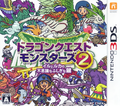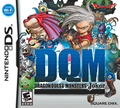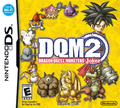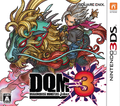Dragon Quest Monsters (series)
Dragon Quest Monsters (ドラゴンクエストモンスターズ Doragon Kuesuto Monsutāzu) or Dragon Warrior Monsters, as it was first known in North America, is a spin-off series of the Dragon Quest games. Published by Enix Corporation until the merger with Square, newer titles have since been published by Square Enix. Dragon Quest Monsters sets the player in a medieval/fantasy world filled with magic, monsters and knights, yet unlike the original Dragon Quest games, the player's character doesn't do any of the fighting in battles; instead the player has to rely on capturing, breeding and raising monsters to do the fighting for them. The concept originated from monster catching introduced when Dragon Quest V was released in 1992. The character and monster designs are by Dragon Ball creator, Akira Toriyama.
Games
Dragon Quest Monsters - (1998)
- See main article Dragon Quest Monsters
The first title in the series was released in Japan on September 25, 1998 (as Dragon Quest Monsters)[1] and in North America in December 1999.[2] It was released for the Game Boy Color before the console itself was released, however the cartridge was backward-compatible with the older Game Boy in black-and-white.
Dragon Quest Monsters 2 - (2001)
- See main article Dragon Quest Monsters 2
The second Dragon Quest Monsters game for the Game Boy Color featured two different versions of the same game, Cobi's Journey (Ruka's Journey in Japan) and Tara's Adventure (Iru's Adventure in Japan). Unlike the first game, this one focuses on attaining keys to unlock new worlds to explore and find monsters.
Dragon Quest Monsters 1*2 - (2002)
- See main article Dragon Quest Monsters 1*2
Dragon Quest Monsters 1*2 is a remake of the original Game Boy games for the PlayStation, and was released only in Japan. The game featured updated graphics and a new interface.
Dragon Quest Monsters: Caravan Heart - (2003)
- See main article: Dragon Quest Monsters: Caravan Heart
Caravan Heart is the third game in the series, released only in Japan for the Game Boy Advance, although a Fan translation exists. It features Keifer, the prince from Dragon Quest VII.
Dragon Quest Monsters: Joker - (2006)
- See main article Dragon Quest Monsters: Joker
Dragon Quest Monsters: Joker for the Nintendo DS, initially revealed through the publication Shonen Jump was released in Japan on December 28, 2006 and in North America on November 6, 2007. It is the latest available English installment in the series and was the first to be featured in full 3D. The game is set around a tournament referred to as the Joker GP. It also features Wi-Fi multiplayer play through the Nintendo Wi-Fi Connection service and full 3D movement and battles. Unlike the other games in the series, this game has no random battles.
Dragon Quest Monsters: Joker 2 - (2010)
- See main article Dragon Quest Monsters: Joker 2
Dragon Quest Monsters: Joker 2 is also for the Nintendo DS, and was released in Japan in 2010. This game will be available in North America in August 2011.
Dragon Quest Monsters: Super Light - (2015)
Dragon Quest Monsters: Joker 3 - (2016)
Dragon Quest Monsters: Joker 3 was released for the 3DS in Japan, so far exclusively, in March 2016. There are no immediate plans to localize the game.
Game mechanics
Battle system
A battles consist of one to three opposing monsters displayed in the center of the screen, with your own monsters Name, HP, MP and Level displayed at the top of the screen.
Once the battle has begun, the player will be given four battle commands:
- Fight: simply lets your monster attack.
- Plan: opens up another menu with another four commands
- Charge: will attempt to make your monster attack with its most direct and powerful attack.
- Mixed: will attempt to make your monster use support abilities, such as shields, stat enhancements, summons and the like.
- Cautious: will attempt to make your monster use defensive abilities, such as heal, revive and abilities that remove harmful stat effects.
- Command: not able to be used in arena battles, command allows you to give direct orders to your monsters.
- Items: opens up your items list and lets you use that item, either on the opposing monster or your own.
- Flee: attempts to flee from the enemy.
Personalities
A message may appear that says "will attempt" for some of the commands; this is because each monster is given a certain personality depending on the player's actions used in combat. Those actions are Charge, Mixed and Cautious, which when used can raise/lower one of three hidden stats, Bravery, Prudence and Caring.
Basically this means a monster high in one of the three stats will be better at using an attack of that type and more likely to obey, for example a monster with the Personality type Reckless (which is high in Bravery but low in Prudence and Caring) will be more likely to use a Charge attack, whereas a monster with the Personality type Careful (a type high in Caring but low in Bravery and Prudence) will be more likely to use a Cautious attack. Personalities change quickly at lower levels than at higher levels, also monsters with a high wildness are harder to change personalities.
The best personality in the game is Hotblood, which is a monster high in everything, and the worst being Lazy, a type low in everything. Personality's make the game more challenging in the arena battles, where the option to give direct commands to your monsters is not available. A monster can have one of 27 personalities.
Wildness
Another reason monsters might not obey commands is their wildness (WLD in the game). A monster with a high wildness is less likely to obey commands. Newly caught monsters will have high wildness, and also monsters kept in the farm for long periods of time. To lower a monsters wildness, the player just needs to keep them in the party for a while or by feeding them meat items.
Capturing monsters
As with other RPG's once the player defeats the opposing monsters and the battle ends, he or she is awarded a certain amount of experience points (EXP) which are used to level your Monsters. At the end of the battle, there exists a small chance the opposing Monster may join the party. In the newest addition to the series, Dragon Quest Monsters: Joker, you actively scout for monsters during battle.
This chance is increased (though not guaranteed) by the use of meat items which lower a monster's wildness. The more the player uses, the lower the monster's wildness will be and the more likely it is to join. Certain types of meat lower a monster's wildness more, thus increasing the chance of catching them.
Currency and items
The currency used in the series is gold (G). Basic items that can be found in all the Dragon Quest Monster games can be found in the Dragon Quest Monster series. Examples include herbs and antidotes. Items are usually bought from vendors, found in dungeons, found in chests, or won from arena battles.
Release dates and systems
In Japan,
- Dragon Quest Monsters: Terry's Wonderland (1998) - Game Boy Color
- Dragon Quest Monsters 2: Iru's Adventure (2001) - Game Boy Color
- Dragon Quest Monsters 2: Lucca's Journey (2001) - Game Boy Color
- Dragon Quest Monsters 1+2 (2002) - Sony PlayStation
- Dragon Quest Monsters: Caravan Heart (2003) - Game Boy Advance
- Dragon Quest Monsters: Joker (2006) - Nintendo DS
- Dragon Quest Monsters: Joker 2 (2010) - Nintendo DS
- Dragon Quest Monsters: Joker 3 (2016) - Nintendo 3DS
In the US,
- Dragon Warrior Monsters (1999) - Game Boy Color
- Dragon Warrior Monsters 2: Tara's Adventure (2001) - Game Boy Color
- Dragon Warrior Monsters 2: Coby's Journey (2001) - Game Boy Color
- Dragon Quest Monsters: Joker (2007) - Nintendo DS
- Dragon Quest Monsters: Joker 2 (2010) - Nintendo DS
Gallery
- DWM Box.png
- DWM2 Cobi Box.png
- DWM2 Tara Box.png
References
- 1. MobyGames. "Dragon Warrior Monsters Japan release date information". Retrieved on September 4, 2007.
- 2. IGN. "Dragon Warrior Monsters United States release date". Retrieved on September 4, 2007.



